The Intel Core i3-7350K (60W) Review: Almost a Core i7-2600K
by Ian Cutress on February 3, 2017 8:00 AM ESTLegacy and Synthetic Tests
At AnandTech, I’ve taken somewhat of a dim view to pure synthetic tests, as they fail to be relatable. Nonetheless, our benchmark database spans to a time when that is all we had! We take a few of these tests for a pin with the latest hardware.
Cinebench R10
The R10 version of Cinebench is one of our oldest benchmarks, with data going back more than a few generations. The benchmark is similar to that of the newest R15 version, albeit with a simpler render target and a different strategy for multithreading.
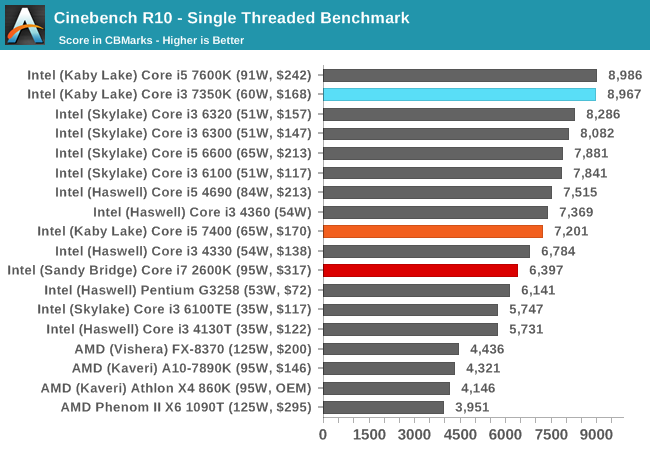
With high frequency in tow, the Core i3-7350K makes its mark.
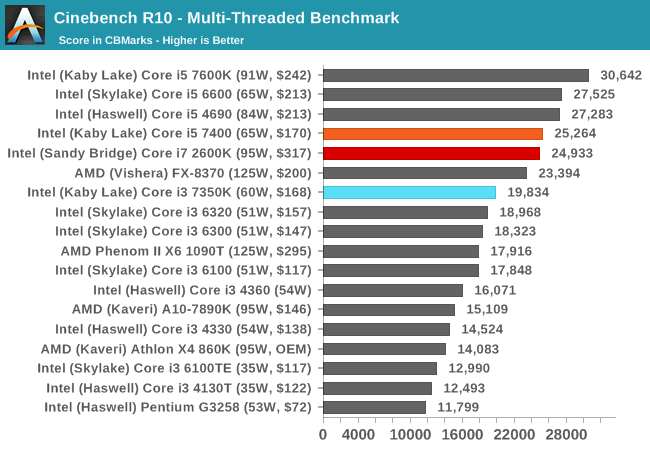
When more threads come to play, the Core i5-7400 and Core i7-2600K battle it out in terms of four cores and IPC vs hyperthreading. The Core i3-7350K sits around ~25% behind.
Cinebench R11.5
CB11.5 has been popular for many years as a performance test, using easy to read and compare numbers that aren’t in the 1000s. We run the benchmark in an automated fashion three times in single-thread and multi-thread mode and take the average of the results.
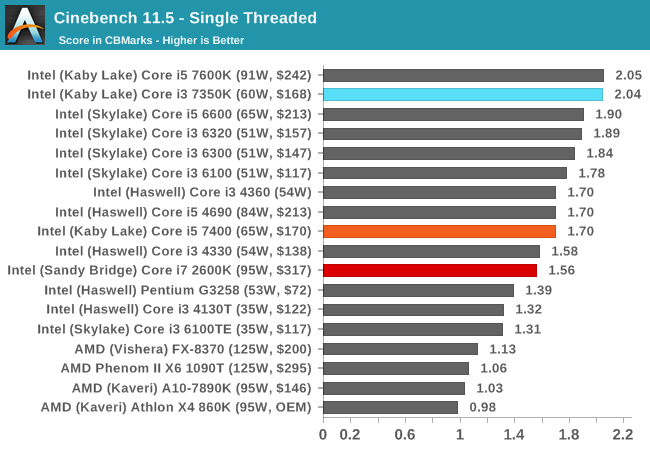
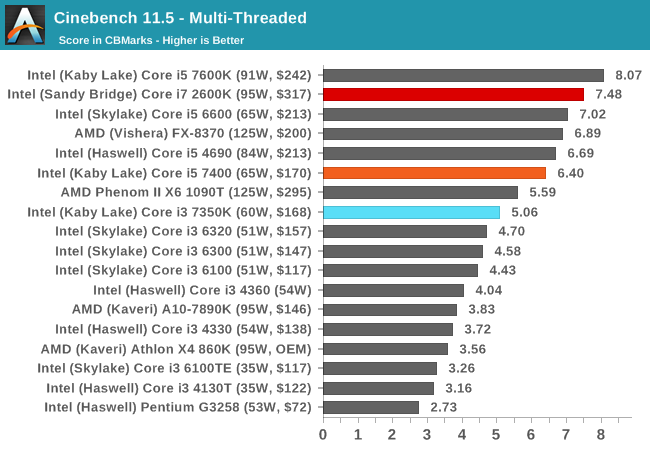
Similar to CB10, the single thread results show that a 4.2 GHz Kaby Lake is nothing to be sniffed at. In the multithreaded test, CB11.5 is more able to leverage the hyperthreads, showing that a Core i7-2600K will run rings around the low end Kaby i5, but is bested by the higher frequency Kaby i5-K. The Core i3 still has that dual core deficit.
7-zip
As an open source compression/decompression tool, 7-zip is easy to test and features a built-in benchmark to measure performance. As a utility, similar to WinRAR, high thread counts, frequency and UPC typically win the day here.
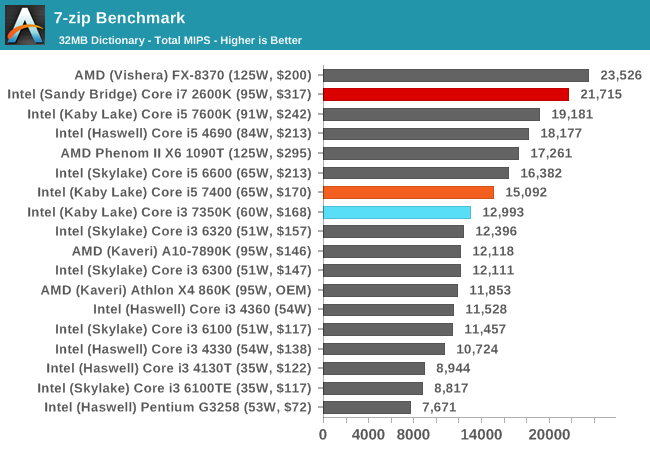
The difference between the i3-7350K and the i5-7400 shows that 7-zip prefers cores over threads, but the Core i7-2600K results show it can use both to good effect, even on older microarchitectures, scoring almost double the i3-7350K.
POV-Ray
Ray-tracing is a typical multithreaded test, with each ray being a potential thread in its own right ensuring that a workload can scale in complexity easily. This lends itself to cores, frequency and IPC: the more, the better.

POV-Ray is a benchmark that is usually touted as liking high IPC, high frequency and more threads. The i7-2600K, despite having double the resources of the Core i3-7350K, is only 30% ahead.
AES via TrueCrypt
Despite TrueCrypt no longer being maintained, the final version incorporates a good test to measure different encryption methodologies as well as encryption combinations. When TrueCrypt was in full swing, the introduction of AES accelerated hardware dialed the performance up a notch, however most of the processors (save the Pentiums/Celerons) now support this and get good speed. The built-in TrueCrypt test does a mass encryption on in-memory data, giving results in GB/s.
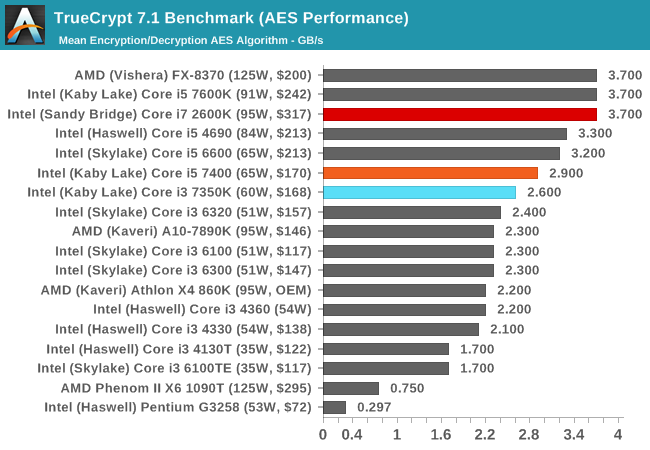










186 Comments
View All Comments
TheinsanegamerN - Friday, February 3, 2017 - link
This chip is 6 years late. Back when sandy bridge was the newest chip, a dual core i3 was a super relevant choice for gaming, a quad core was overkill.Today, for gaming builds, a i5 chip is almost always a better choice, unless you only play games that are single threaded. And the i3 is more power hungry then locked quad cores.
At $130, this would be a great choice, but ATM, the i3k is overpriced for what it offers for a modern system.
nathanddrews - Friday, February 3, 2017 - link
I'd argue that with the introduction of this i3 K-variant and the new hyperthreaded Pentium, Intel just gave a lot of people a reason to not by an i5. The message from Intel seems to be this:"If you need great single-threaded performance with some mild multi-threaded, get the Pentium or i3. If you need great multi-threaded performance with great single-threaded, get an i7."
I'd say they are preemptively stacking the product deck prior to the release of AMD Ryzen - offering entry-level gamers more options without diluting their HEDT status.
BedfordTim - Friday, February 3, 2017 - link
In many of the games an i3-6100 offers effectively the same performance and is $50 cheaper. It isn't a case of the i-3750k offering great performance, so much as the games are not CPU limited. This points towards an even more expensive graphics card and the even cheaper CPU.jayfang - Friday, February 3, 2017 - link
Agree. Whatever about actual performance, it seems quite clear the cool factor of "unlocked" Ryzen's and joining the "overclocking community" is getting a pre-emptive strike from Intel.Michael Bay - Saturday, February 4, 2017 - link
OC never had a "cool factor".eldakka - Sunday, February 5, 2017 - link
In the late 90's into the early 00's, when people would travel for hours carting their PC to a LAN gaming event with 100's (or even thousands) of other people, having an OC'ed machine was indeed cool amongst that Geek crowd./em remembers his dual celeron 300A's OC'ed to 450MHz (yes, that's Mega - not Giga - hertz).
drgoodie - Tuesday, February 7, 2017 - link
I had a dual 366Mhz Celeron box OC'd to 550Mhz. It was cool back then.dsraa - Tuesday, February 14, 2017 - link
It was indeed and still is very very cool......I had been OC'ing my systems way back to the original Pentium 100, and then got a Celeron 300, OMG those were the days....If you don't think its cool, what the hell are you doing on Anandtech??!??!!!?DLimmer - Wednesday, February 15, 2017 - link
You may have missed the joke. This was a play on words; Overclocking produces more heat so it's "not cool."DLimmer - Wednesday, February 15, 2017 - link
OC is "hot, hot, hot"!